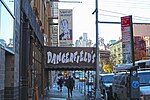Payne Whitney Psychiatric Clinic
The Payne Whitney Psychiatric Clinic (PWC) was a hospital in the Upper East Side of Manhattan, New York City, which was founded by an endowment bestowed by Payne Whitney (March 20, 1876 – May 25, 1927) upon his death. Whitney was an American businessman and member of the influential Whitney family. An eight-story free-standing hospital was constructed, and was affiliated with Cornell University's medical school, now called Weill Cornell Medicine, and with New York Hospital, now New York–Presbyterian Hospital (NYP), before its opening. Payne Whitney was a large donor to the Hospital and Medical College, and it has been an issue of long speculation why he chose a psychiatric building to be his primary naming opportunity at New York-Cornell. The Payne Whitney building itself was torn down in the early 1990s to make way for an expansion of the New York-Presbyterian Hospital over the FDR Drive. Since that time, all clinical and research services at the two primary Cornell psychiatric campuses—in Manhattan and in White Plains, New York—have been named after Payne Whitney. The clinic also has an outpatient and Continuing Day Treatment Program in an off-campus building at East 61st Street and York Avenue in the Upper East Side.
Excerpt from the Wikipedia article Payne Whitney Psychiatric Clinic (License: CC BY-SA 3.0, Authors).Payne Whitney Psychiatric Clinic
East 61st Street, New York Manhattan
Geographical coordinates (GPS) Address Nearby Places Show on map
Geographical coordinates (GPS)
| Latitude | Longitude |
|---|---|
| N 40.75991 ° | E -73.9588 ° |
Address
East 61st Street 501
10065 New York, Manhattan
New York, United States
Open on Google Maps










